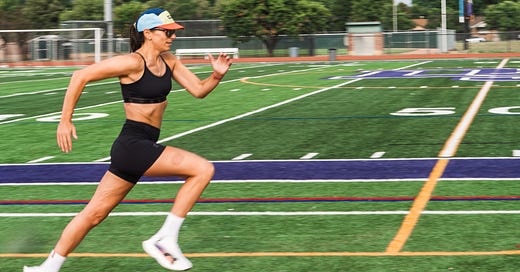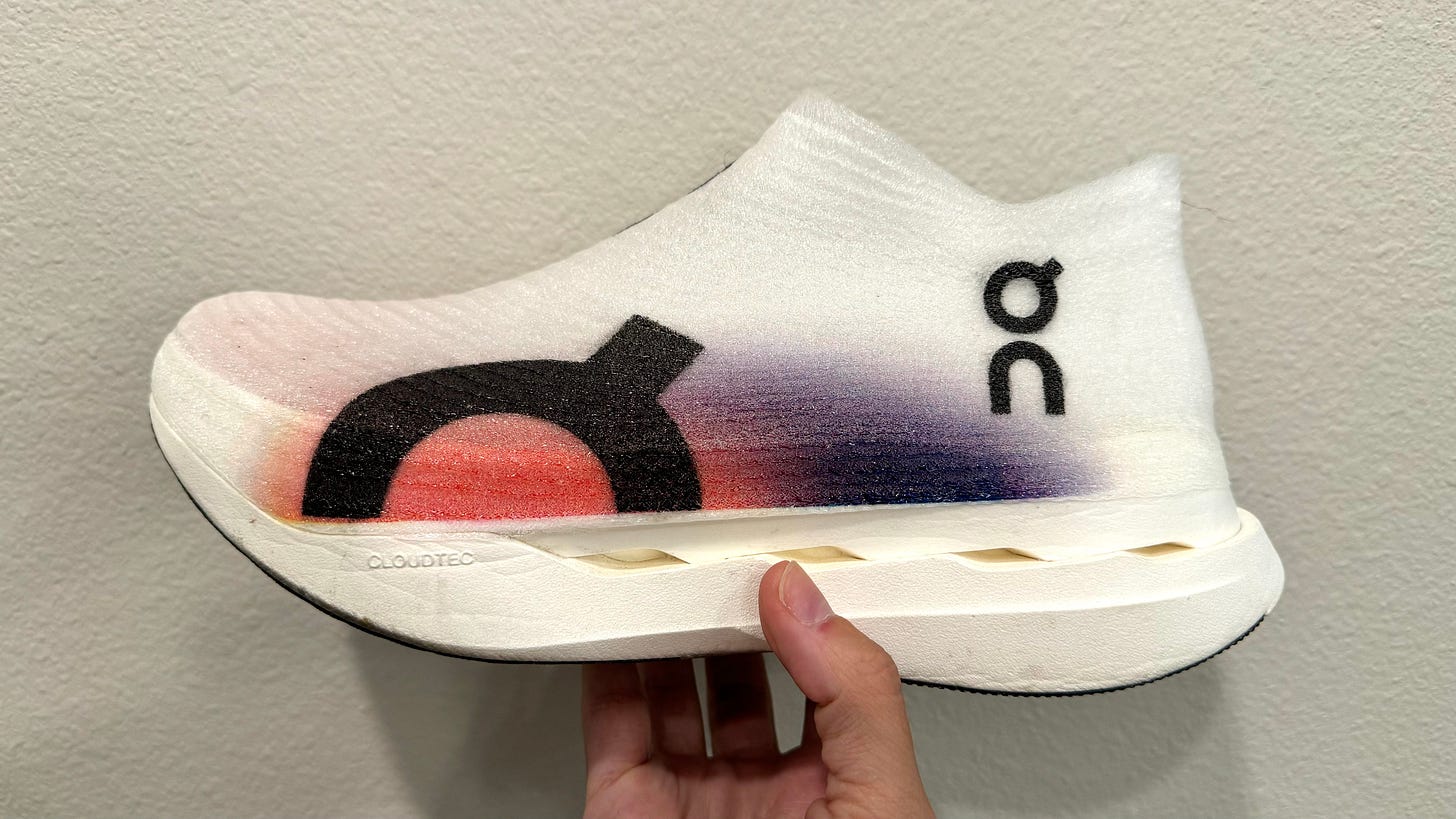Where Is All the Money In Running?
The Olympics are highlighting just how hard it is to make a living as a professional athlete.
The Olympics are underway, and every day brings a new favorite internet moment: New Zealand rugby sevens player Michaela Blyde meeting her idol, Jamaican sprint queen Shelly-Ann Fraser Pryce; USA rugby star Ilona Maher shutting down a TikTok commenter who criticized her weight; American gymnast Stephen Nedoroscik crushing a seamless routine on the pommel horse to help Team USA medal for the first time since 2008.
One unlikely celebrity hero: Flavor Flav. The rapper just signed a five-year sponsorship deal as the official hype man for the USA Water Polo Women's and Men's National Teams; as part of this sponsorship, he’ll make a financial contribution to the 2024 USA Women's Water Polo Olympic Team. Why? He found out that team members were working multiple jobs just to continue training and competing despite winning three straight Olympic gold medals and currently competing for their fourth.
The Public Enemy rapper might seem like an odd hype man for water polo, but I think this kind of celebrity endorsement is a genius move—and it brings to light a major issue plaguing not just the Olympics, but the majority of professional athletics.
The term “professional athlete” might conjure up images of couture, fancy cars, and McMansions, but unless you’re an NBA or NFL star (or you’re Simone Biles, who earns $5 million a year in endorsement deals), that’s probably not the case. Just look at Caitlin Clark, this year's number one draft pick in the WNBA, whose starting salary with the Indiana Fever was just $76,535 a year. The median annual wage for athletes and sports competitors was actually $70,280 in May 2023, according to the Bureau of Labor Statistics.
Running, unfortunately, is not one of the more lucrative professional sports (unless you’re Noah Lyles, who has the richest contract in track and field since the retirement of Usain Bolt). Top collegiate runners with multiple NCAA titles might get $100,000 annually from big brands like Nike, Adidas, Brooks, Saucony, and Hoka, while midcareer athlete with a breakthrough performance might get a base contract worth $50,000 to $100,000, and less standout runners might be looking at deals for about $30,000 to $75,000 per year, Sarah Lorge Butler reported in Runner’s World back in 2021. (FYI: On the trail side, a 2023 survey of nearly 200 trail running athletes published by UltraRunning magazine found that 64 percent of respondents reported making less than $20,000 in total earnings last year, while 34 percent of respondents reported earning less than $5,000.)
That sounds pretty bleak, right? Still, sponsorships are crucial when it comes to funding training, gear, travel to meets, and everything else that comes with pursuing a physical goal at the highest level. We’re used to seeing runners in brands like Nike, New Balance, and Adidas, but at the U.S. Olympic Trials, it was exciting to see how track and field athletes and brands are thinking outside of the box when it comes to sponsorships.
Tracksmith’s Amateur Sponsor Program—which provides support for post-collegiate athletes who have yet to receive professional contracts—sent five athletes from the Trials to Paris: Freddie Crittendon took silver in 110m hurdles with new PR of 12.93; Marisa Howard, placed third with a 15-second PR in the steeplechase; Chris Bailey placed third in the 400m; Chris Thompson came in first in men’s javelin; Justin Stafford took bronze in the hammer throw with a personal best of 77.07; and Kara Winger threw the javelin 62.94 meters to win the silver medal.
Bandit Running also supported athletes via their Unsponsored Project, which provided 35 athletes with unbranded gear and a modest cash stipend. Last Olympics, the program helped Ahmed Muhumed and Rachel McArthur secure footwear sponsorships with Hoka and ASICS, respectively; this year, Trevor Bassit is heading to Paris after placing third in the men’s 400m hurdles.
Lululemon will be represented on Team USA by Tara Woodhall-Davis in the long jump and Nikki Hiltz in the 1500-meter race, while FP Movement is sponsoring UK athletes Jessie Knight, a 400-meter runner, and Jess Hunter, a 100-meter hurdler.
It’s refreshing to see newer brands stepping up to support athletes, but gear and stipends only go so far. Trevor Bassit is a two-time World Champion in the 4x400-meter relay, two-time World Indoor Championships Silver Medalist, and World Championships Bronze Medalist in the 400-meter hurdles, but his wife Harlie Bassitt had to launch a GoFundMe campaign to help support his career (since it launched on July 2, 2024, it’s received $27,265 in donations). Sprinter Brittany Brown, a first-time Olympian, and her family also started a GoFundMe campaign on July 8, 2024 to cover trip costs to Paris with just a month’s notice. (This feels especially egregious when you consider how USA Track & Field CEO Max Siegel made $3.8 million in 2021, while top athletes were given a $12,000 stipend; his contract was extended in 2023 to 2028.)
The sport’s governing bodies and event organizers are starting to rethink the way track and field compensates athletes. This summer, track and field will be the first Olympic sport to award gold medalists prize money—an extra $50,000—World Athletics recently announced; payments for silver and bronze medalists will start at the 2028 Olympics in Los Angeles. In the meantime, Michael Johnson recently announced Grand Slam Track, a series of meets starting in 2025 that will sign 48 men and women “who, as part of their contract, can earn a slice of group licensing and revenue opportunities, plus prize money, on top of a base compensation by meeting an obligation to start all four meets,” according to an article in Runner’s World. Alexis Ohanian’s women’s-only track meet, Athlos, plans to pay winners $60,000—that’s $10,000 more than an Olympic gold medal, and double a win at the Diamond League final, the New York Times reported.And in June, World Athletics announced its Ultimate Championship, a biennial event kicking off in 2026 that will pay $150,000 to winners (and World Athletics pays a $100,000 bonus to athletes who break a world record).
With running in the midst of its biggest boom since recreational jogging went mainstream in the 1970s and some professional runners on the cusp of superstardom (see: Sha’carri Richardson and her Vogue cover), it’s encouraging to see potential opportunities for athletes to be better compensated for their performances—and the entertainment the rest of us enjoy while following their journeys.
The running events at the 2024 Olympic Games in Paris start on Friday. Before things get underway, check out a few of the Olympic stories I’ve written recently:
Alysia Montaño Calls Out An “Unforgivable” Trend In Professional Running
Nia Akins Is Laying Down Tracks and Getting Faster on the Track
the rundown
On Cloudboom Strike LS
This shoe has been driving social media crazy, and for good reason: It’s one of the most innovative running shoes we’ve seen recently. The On Cloudboom Strike LS—for Light Spray—is a more elite, more exclusive version of the Cloudboom Strike that was released last month. The main difference: a seamless, stretchy, super lightweight spray-on upper. Honestly, it looks like something you’re going to tear in two just trying to get it on your feet, but the thermoplastic material is surprisingly durable and retains its shape even after slipping it on and off multiple times. Both versions feel great underfoot, which surprised me because I don’t really love any other On shoes; the midsole features two layers of Helion HF Hyper foam, with a big chunk under the forefoot for lots of bounce and forward propulsion. You’re definitely going to see the shoe in Paris next week.
Acute Sleep Deprivation Impairs Overall Athletic Performance
If you’re reading this right at 4 a.m. when it hit your inbox, go back to bed. Not getting enough quality shuteye significantly impairs the overall athletic performance of athletes—affecting aspects like skill control, speed, aerobic endurance, and explosive power—according to a March 2024 meta-analysis published in the journal Nature and Science of Sleep. There are a few reasons why: Sleep deprivation increases energy consumption and leads to a decline in muscle glycogen and liver glycogen reserves; it also reduces cognitive functions, including attention, which can have negative effects; and it hinders the repair of the immune system, increasing inflammation. Consider this your excuse to sleep in tomorrow.
What’s Going On At Nike?
It feels weird to share a LinkedIn post, but if you’re at all interested in what’s going on at Nike lately, this one from the brand’s former CMO is a must-read. It details Nike's transition from a brand-driven creation engine to a data-driven direct-to-consumer model that’s led to an impressive loss of earnings (not helped, obviously, by the recent success of brands like Hoka and On). Here’s my favorite quote: "Nike invested a material amount of dollars (billions) into something that was less effective but easier to be measured vs something that was more effective but less easy to be measured. In conclusion: an impressive waste of money." Ouch.







That LinkedIn post was super interesting